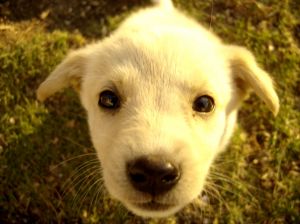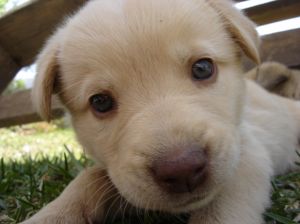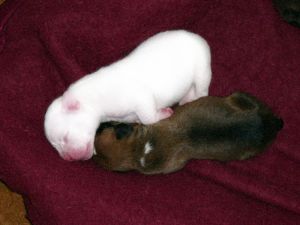 Before You Buy that Puppy
Before You Buy that Puppy
by David the Dogman.
Date: 19 February 2010

"How much is that doggy in the window, the one with the waggly tail...?" Familiar words to an old tune suggests that many people at one time or another consider having a dog as a pet.
They might have fond memories of the old Boxer or Cairn terrier that they grew up with.
Maybe it was a good-natured mutt or even a neighbour's well-behaved German Shepherd. Some folks imagine owning a beautiful and heroic dog such as "Lassie" of book and screen fame.
Often, the reality is that many pups purchased on impulse, wind up in shelters or banned to a chain in the garden because they didn't measure up to the dream. This article is written to help you consider the answers to the questions you should ask before buying that cute little puppy.
Are you ready for a life long commitment to responsible dog ownership? Let's think through and visualize what dog ownership is really like. It is fun to imagine walking an obedient dog on a beautiful day, but remember, the same dog will need walking when its hot, cold, raining or icy out. The "Obedient" part will take time and effort. In deciding whether a dog will fit into your lifestyle, the biggest consideration in the long run will be "Do you have the TIME it takes to own a dog?
Questions
Some dogs need more time than others do, but every dog requires time for daily interaction beyond just meeting its basic needs. Consider your lifestyle and personality when deciding if a dog would fit into the picture.
- Why do you want a dog?
- How active and busy are you?
- What do you do with the dog when you travel or are on vacation?
- Do you have young children?
- Do you have a fenced garden?
- How big is it?
- How long at a time will the dog be alone in the home?
- Does anyone have allergies? (Easier to find this out visiting someone else's dog first) Would you have the time to start with an untrained puppy or would you be willing to re-train an older dog?
- What kind of fur and how much grooming/shedding are involved?
- What size would fit in?
- Purebred? Mixed? Male? Female? Large? Small?
Dogs needs
Puppies and adult dogs have daily needs. The basics are shelter, food and water, grooming, health care, training, exercise and social interaction. The earlier in life you start teaching a pup what is expected of it the better, but the more it has to learn. With an older dog, there may be some bad habits they'll have to 'unlearn'.
Early social experiences set the tone for a dog's development into a dependable companion or a destructive nuisance.

Training
Socialization Puppy Training (9-18 weeks.) will certainly mold the pup during its most impressionable period and helps provide an environment for learning positive associations with new people, places, experiences and other dogs.
Patterns are set for life in these formative weeks. However it is essential that young dogs from 4 months to one year attend training classes.
Cost
Besides training, there are other expenses incurred with dog ownership. After the initial purchase, the biggest portion will go toward veterinary and feeding bills.
A high quality food costs more 'per bag' but is very cost effective in terms of better health and food efficiency (you feed less).
Veterinary start-up costs, including immunizations and worming, Microchips are also required by law for identification is not cheap. Neutering and spaying usually takes place around 6 months. Semi-annual vet visits, heartworm testing and preventative medications, unexpected illnesses or accidents all add up! Then there is the control of internal and external parasites to consider (worms, fleas, ticks, mosquitoes and mites etc.)
Grooming requires the proper tools to care for coat, ears, teeth, and nails. (For some breeds, there is the additional expense of a professional groomer 8-9 times a year.) Microchips are also required by law for identification.
Basic supplies include sturdy food and water bowls, leash and collar, bedding, cage, chew toys, food treats, indoor gates, outdoor fencing, kennels and housing.
Although lovable, puppies and dogs will create additional cleaning work around the home. (Accidents: diarrhea, urine, vomit), shedding hair, muddy paws, drool, tracked on floors and carpeting, nose prints on windows etc.) Responsible dog ownership dictates cleaning up dog garden waste, keeping dogs reasonably quiet and confined to their own property.
Dogs are known for destructive chewing and digging holes. These problems can only be successfully dealt with through supervision and confinement and early puppy training (starting at two months.)
So, why on earth would anyone want a dog with all the work, time and expense of owning one? For many reasons, but the biggest one for most people is that they enjoy the loyalty and companionship of a dog. Dogs like to play.
Folks like the way they interact in the family, the way that the dog looks and the home security a properly trained dog can add. If you are willing to make a time commitment for the next 10 years (the average life span of a dog); knowing the responsibility and expense of owning a dog and fully aware of the likely negative elements involved, then, the next step would be to decide what kind of dog best fits into your lifestyle.
Breeds

Do not make the drastic mistake of choosing a breed solely on its 'looks'. Although this is one consideration, the temperament, size, activity level and coat care are even more important considerations.
Unfortunately a pup is sometimes chosen impulsively because it looked like a 'cute little teddy bear' and then the teddy grows up to me more like a 'grizzly' because the breed is a type bred for high levels of aggression. Or a pup may prove to have an energy level that requires more exercise and attention than can be provided.
Research
Research the breeds that appeal to you. Libraries carry breed books and local veterinarians may be able to put you in touch with reputable breeders. Local dog shows allow you to view a variety of purebred dogs. Find out about the positive and the negative traits of each breed you are considering.
Ask questions: How big do they get? How much grooming is required? How aggressive are they? How active? How much exercise is required? Are they good with children? Are allergies a consideration? Don't discount mixed breeds.
Good Luck with your new pet and come to training classes.